Director’s Bulletin | July/August 2023
News and updates from WDFW Director Kelly Susewind
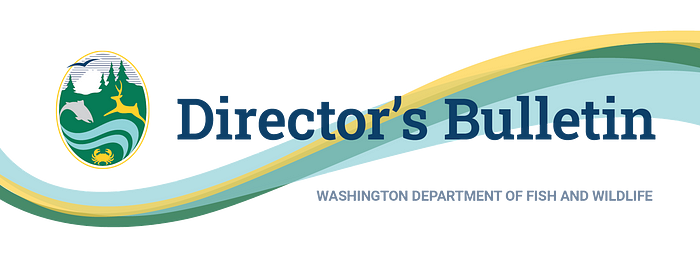
Every day in the national and state news, there is evidence of how climate change is impacting our lives. June and July were the two hottest months in human history, water temperatures in Florida hit triple digits, and the wildfires in Hawaii are responsible for the death of more than 100 people and rising — making it our country’s deadliest wildfire in a century. From drought to intense hurricanes, to devastating wildfires in Canada, Maui, and right here at home, the economic toll is staggering. The loss of life is devastating.
A changing climate is already affecting Washington state’s fish and wildlife resources. Increasing stream temperatures and low summer flows have resulted in fish die-offs and fishing closures along our rivers. Declines in snowpack and wildfires have damaged critical habitat and pose significant management challenges for many of our threatened or endangered species. Continuing climate change will exacerbate these and other climate-related impacts, further challenging our ability to fulfill the mission to “preserve, protect and perpetuate fish, wildlife and ecosystems while providing sustainable fish and wildlife recreational and commercial opportunities.”
While the challenges we face are serious, they are not insurmountable. The Washington Department of Fish and Wildlife (WDFW) is taking a holistic response to climate change that spans two related but distinct categories:
- Building resilience to and preparing for the impacts of a changing climate.
- Reducing greenhouse gas emissions generated by agency operations.
The agency’s climate resilience work is largely informed by the 2021 report, ‘Preparing WDFW for a Changing Climate: Assessing Risks and Opportunities for Action’ and the agency’s greenhouse gas reduction work is guided by the ‘WDFW Sustainability Plan’ released in 2022.
To support these efforts, we prioritized climate change in the agency’s 2023–25 budget proposal through two coordinated requests to support the urgent action necessary to both reduce and prepare for climate change. The Legislature appropriated $4.4 million for climate-adaptation centered research, capacity building, engagement, evaluation, and monitoring across WDFW’s activities. Some projects funded in this request include:
- A Habitat Connectivity Action Plan for Washington State that leverages existing connectivity science and mapping efforts in Washington. The Action Plan will identify the highest priority locations for connectivity conservation or restoration in Washington state including both priority road crossing locations and locations and regions critical to providing landscape-scale connectivity.
- Stream Temperature Modeling and Monitoring: Monitoring stream temperature throughout Washington and generating models of current and future stream temperature will inform restoration planning, identify areas for protection, and help understand climate change threats to aquatic species.
- Localizing Climate Projections: This will support further refinements to generate streamflow projections of current and future conditions. This data will be used to ensure WDFW’s climate-smart culvert tool is using the best available streamflow projections as the field of climate change science advances.
- Vulnerability Assessment of WDFW Lands & Infrastructure: Understanding the impacts of climate change on WDFW lands and infrastructure is a necessary foundation for reducing climate risks, protecting the agency’s investments, and ensuring continued program success.
The agency also received $1.75 million to support priority climate change mitigation initiatives outlined in the WDFW Sustainability Plan, including:
- Installation of electric vehicle charging infrastructure in facilities around the state to ensure we have chargers to support more electric fleet vehicles.
- Feasibility studies for installation of solar panels at offices and micro-hydro power systems at hatcheries.
- Expansion of the agency’s Commute Trip Reduction program to offer financial incentives to staff for carpooling, public transit, biking, and walking to work.
Here’s the bottom line: the climate is changing; the impacts are real and pose a direct threat to our mission.
What gives me hope is that human-caused climate change may finally be getting the attention it needs to move the needle. Nationally, the 2022 federal Inflation Reduction Act — the single largest climate investment in American history — stands to transform the nation’s energy and transportation systems and devotes billions to climate resilience and conservation projects around the country. Here at WDFW, we are responding to climate change through work across the entire agency. We are redesigning culverts to withstand higher peak streamflow, investing in wildlife crossing structures over and under state highways, improving forest health on WDFW lands, restoring estuaries and other climate-impacted habitat…the list goes on.
Looking ahead, we will expand collaboration with other agencies, partners, and stakeholders, to take the all-hands-on-deck response demanded by the scale of this problem. Our sleeves are rolled up; let’s get to work.
Sincerely,
Kelly Susewind, Director


Conservation-minded management approach validates sustainable salmon fisheries
Washington’s environmentally conscious consumer base wants information on fisheries management to help them make sound, conservation-minded seafood purchases, especially when it comes to salmon. Learn how WDFW manages salmon stocks for both Southern Resident orcas and people in this July blog post and our new 3-minute video. WDFW, tribal co-managers, and federal fisheries agencies use strict science-driven and highly monitored programs to manage Washington’s salmon fisheries — in fact they are among the most stringent in the world. As for recreational fisheries, WDFW salmon managers know that tens of thousands of anglers look forward to our state’s salmon seasons every year, with many planning summer trips months in advance. After recent in-season closures in Puget Sound, we published a blog post from our Fish Program Director about why these changes were necessary and how salmon fishing in “mixed stock” saltwater areas is managed, as well as a short video: The Science of Salmon Management. Looking for recipes to cook salmon at home? Check out this guest blog from acclaimed Pacific Northwest food writer Nancy Leson.

Wildfire updates and responsible outdoor recreation
Wildfires hit our state hard in August. Before heading out to hunt, fish, or enjoy other outdoor recreation, be sure to check WDFW’s Washington Wildfire Information page to make sure the area you will be visiting has not been impacted. You may also want to review the Department of Natural Resources (DNR) Current Wildfire Incident Information webpage and the federal government’s InciWeb. Despite recent rains, a reminder that fire restrictions are still in place on Eastern Washington lands managed by WDFW. That means no campfires, target shooting, or other activities that could start a wildfire. More information on restrictions is also on the Wildfire Information page. Some private timberlands across the state are closed due to fire risk and a large portion of public lands in north-central Washington are currently closed for safety reasons due to the Crater Creek Fire and other wildfires. This means hunters, particularly those who participate in the High buck Hunt and September archery seasons, should be prepared to find alternate hunting areas. Tips for responsible recreation to avoid starting fires can be found at recreateresponsibly.org/wildfireresponsibly

Crabbers: don’t drop pots in ferry lanes and submit summer Catch Record Cards
Labor Day marks a seasonal milestone for Washingtonians in Puget Sound: the end of summer crabbing in many areas (see current recreational crab seasons on our webpage; some areas remain open longer). That means it’s time to look ahead to the winter season, but also time to submit your summer Puget Sound Dungeness crab Catch Record Card (CRC). Catch Record Cards for the summer season can be mailed to the physical address listed on the card as soon you are done crabbing for the summer period. Alternatively, they can be submitted online by logging in to WDFW’s online licensing system starting Sept. 5th. You can also drop your CRC off at one of WDFW’s regional offices. Summer cards must be submitted by Oct. 1 for any crabbing that occurred between the season opener through Labor Day. You must report your catch even if you didn’t catch any crab! In the Puget Sound region, crabbers are reminded to not drop pots in ferry lanes and other high traffic areas. Crab gear in ferry lanes have caused serious damage to Washington State Ferries in past years. Tips on responsible crabbing including how to properly mark your gear are available in this July blog post.
Paddling Together; WDFW and Stillaguamish Tribe collaborate to restore habitat and raise Chinook
Originating on the western slopes of the Cascades near the Mountain Loop Highway and flowing into Port Susan and Puget Sound near the city of Stanwood, the Stillaguamish River is small compared to many other Washington rivers. Yet due to seriously endangered runs of wild Chinook, impacts on Stillaguamish salmon play a major role in fisheries management throughout much of Western Washington and beyond. Restoring habitat to recover salmon and steelhead in “the Stilly” is a top priority for WDFW, the Stillaguamish Tribe, Snohomish County, and other partners. In August we released “Paddling Together”, our latest short film on Stillaguamish recovery efforts, as well as a blog post detailing collaboration between WDFW and the Tribe on habitat restoration and a program raising Chinook using integrated hatchery broodstock.
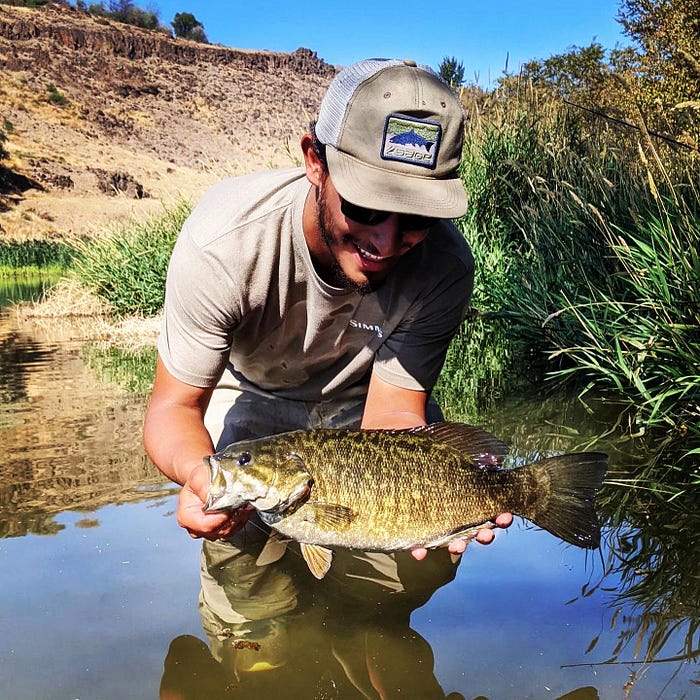
Bass Week recap and non-native gamefish management
WDFW’s Bass Week, held every July, is a fun way to learn about bass and bass fishing in Washington. From what tackle to use to the best times to fish for bass, to finding shore access and techniques to get you started, warm water fish biologists use Bass Week as an annual opportunity to discuss all things bass. You can find how-to and other videos from Bass Week 2023 on WDFW’s YouTube channel. Our legal mandate requires WDFW to preserve and protect Washington’s fish and wildlife resources, while simultaneously maximizing opportunities. One way we do this is by managing for quality fisheries for bass and certain other non-native gamefish species, many of which were introduced more than a century ago and are now widely distributed across our state. In areas that are not considered “anadromous waters” and thus are not home to migratory salmon, steelhead, trout, and lamprey, we often seek to promote and manage for bass and non-native gamefish populations and fisheries. Because bass and other non-native gamefish such as perch and walleye prey on juvenile salmon and steelhead, in anadromous waters we follow Commission policy and state law by removing or liberalizing catch limits on non-native gamefish to reduce their impacts — though many quality fishing opportunities remain, from the Columbia River to Western Washington including Lake Washington and Lake Sammamish. We’re proud to offer these diverse fishing opportunities while limiting impacts on native fish species.

WDFW wrapping up a busy summer of outreach events
We’ve had a busy summer connecting with communities across the state at numerous events and activities. Our Communications and Public Engagement (CAPE) team and other staff regularly provide hands-on learning opportunities, educational materials, and presentations for people to connect with nature wherever they are. Since June, WDFW participated in more than 30 events and helped people learn about local fish and wildlife, invasive species, observe animals on public lands and in their own neighborhoods, and create wildlife habitat around their homes and communities. In addition to hosting informational booths, the Department sponsored several events this season including Refuge Outdoor Festival, Capital City PRIDE, and South Tacoma Heritage Festival. WDFW partnered with the Educational Service District 123 in early August and participated in the Migrant Education Program’s leadership camp for students from the Pasco region. Staff facilitated various activities for 9–10th grade students focused on fish and wildlife exploration near Mount Si. Other public engagement activities this summer included installation of four free wildlife-viewing telescopes on WDFW wildlife areas. These telescopes are ADA accessible and have lenses designed for people with colorblindness. Additionally, four recipients were selected for WDFW’s 2023 Watchable Wildlife Grant out of over 50 applications submitted.

NOAA certification of WDFW Ocean Sampling Program
This July, the National Oceanic and Atmospheric Administration (NOAA) Fisheries announced the certification of one of WDFW’s fishing surveys — the Ocean Sampling Program — through its Marine Recreational Information Program (MRIP). This MRIP certification means that NOAA found the survey, through an independent peer review, to be a statistically valid approach to meet survey objectives and provide key recreational fishing estimates. Surveys that have been certified are eligible to receive additional federal funding reserved for MRIP-certified programs. WDFW’s Ocean Sampling Program (OSP) conducts dockside sampling of recreational and commercial catch of salmon, groundfish, tuna, and other species across Washington’s four ocean ports, working in coordination with recreational anglers, charter captains, tribal fisheries staff, commercial fishers, and others. OSP also collects Voluntary Trip Reports and conducts onboard observations and other data collection efforts to guide sustainable fisheries off our state’s coast.

Why did the deer cross the road? Wildlife crossings and habitat connectivity efforts
From pronghorn to pikas, wildlife big and small need ways to access resources like food, water, and shelter, and human travel corridors can impede the movement of wildlife, particularly where they intersect habitat corridors. Wildlife scientists and transportation experts are working together on ways to promote connectivity between wildlife habitat fragmented by highways or other infrastructure, including WDFW, the Washington State Department of Transportation (WSDOT), the Washington Habitat Connectivity Working Group, and other partners. Learn more about growing efforts to connect habitat across Interstate 5 for cougars, fishers, elk, and other species in southwest Washington in this July blog post. This work builds on the success of wildlife crossings under and over I-90 in the Central Cascades east of Snoqualmie Pass.

WDFW launches effort to develop strategy for prioritizing barrier removal to support migrating fish
We kicked off an effort this summer to develop a comprehensive statewide strategy outlining an approach to prioritize barriers for removal that prevent salmon and steelhead from swimming upstream. Learn more in our news release. Directed by the 2020 Legislature, the strategy will better focus progress across Washington’s culvert correction programs into a single strategic approach to maximize salmon and orca recovery efforts. The strategy will help to guide future funding recommendations for the state’s Brian Abbott Fish Barrier Removal Board, as well as other state fish passage barrier correction programs. The Department recently convened a science panel to guide the strategy development and is also coordinating with tribal governments, salmon recovery regions, and key stakeholders in the development of the strategy. More information about the panel is available on the Department’s webpage.
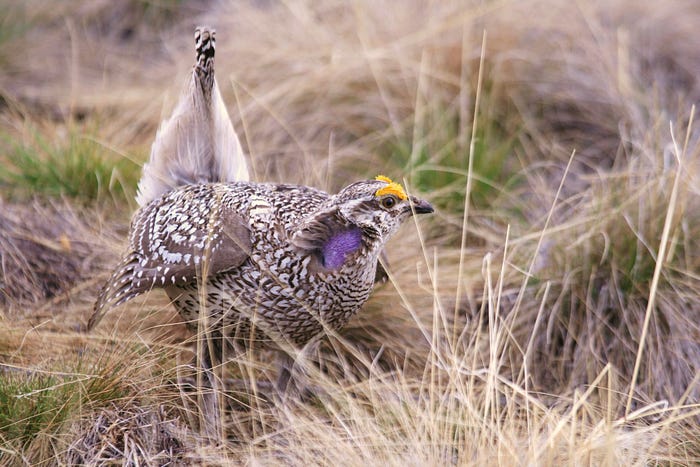
International cooperation supports sharp-tailed grouse recovery, comment on status review for northern spotted owl
The Columbian sharp-tailed grouse is a Washington state endangered bird and the rarest subspecies of sharp-tailed grouse. Their Washington population may have once numbered in the hundreds of thousands, but today there are fewer than 600 birds. Since 2018, WDFW has been working with biologists in British Columbia and other partners to bring Columbian sharp-tailed grouse from Canada to north-central Washington to boost this endangered population. Learn more in our new blog post. Speaking of rare birds, a recent status review by WDFW determined that, despite forest management and conservation actions that have reduced the rate of northern spotted owl habitat loss, the Washington sub-population of spotted owls is still facing challenges that threaten population recovery. We have recommended to the Fish and Wildlife Commission that the northern spotted owl stay on the state’s endangered species list, and the Department is accepting public comment on the status review through Oct. 29. Learn more in our August news release.

Preparing for fall hunting seasons including highlights and hunter education
Aug. 1 marked the beginning of big-game hunting seasons in Washington with the fall general black bear season, followed by archery deer on Sept. 1 and archery elk on Sept. 9. The High Buck Hunt is another popular deer opportunity on the horizon and is only open in select designated Wilderness areas. If you have your sights set on notching a big-game tag this fall, be sure to carve out time to prepare by visiting myWDFW.com, where we share “Life Outdoors” tips and hunting and fishing highlights, as well as promotions and licensing information. In a new article titled “Be ready for fall’s big-game seasons” we cover three fundamental topics that create a foundation for hunting success. On the small-game hunting side, turkey and grouse seasons get under way in September, as well as several upland game bird opportunities. Check out our blog for more hunting tips for upland game birds, fall turkey techniques, and identifying and hunting forest grouse. And, be sure to always check hunting regulations before heading afield. If you haven’t already completed your mandatory hunter education course, don’t delay! To learn about hunter education, please visit the WDFW hunter education webpage.
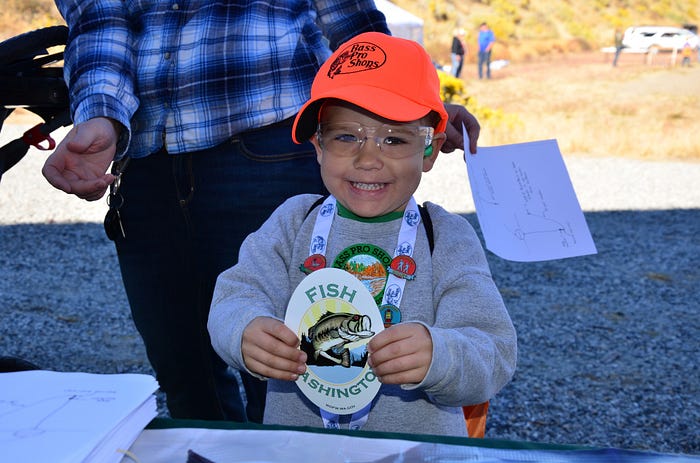
National Hunting and Fishing Day on Sept. 30
The National Hunting and Fishing Day event, hosted by WDFW, the Kalispel Tribe, and the Colville Confederated Tribes is a great way to introduce youth to hunting, fishing, gathering, and outdoor recreation. This year’s event takes place Sept. 30 in northeast Washington near Newport. Youth 17 and younger can shoot firearms, archery equipment, and air rifles. There will also be fishing, conservation displays and activities, door prize drawings, casting practice, knot tying, fish prints, casting plaster wildlife prints, bear spray demonstrations, a virtual turkey hunt, live birds of prey, and a backcountry camp with horses and mules. This event is free but be sure to register online in advance to make sure there are enough materials for all. Want to volunteer? If you can help, please visit our volunteer page for more information and to sign-up.
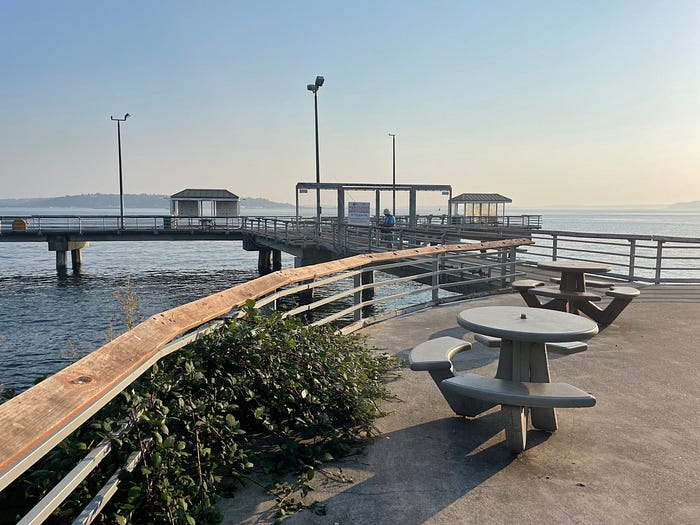
Project to revitalize parks on Seattle Waterfront, including WDFW’s Elliott Bay Fishing Pier
WDFW manages more than a million acres of state public lands, from remote wildlife areas to shellfish beaches and water access areas. But did you know we also have a facility on the Seattle Waterfront? The Department manages the Elliott Bay Fishing Pier (also known as Pier 86) at the Port of Seattle’s Centennial Park. This popular pier was once a hub for urban anglers from all backgrounds, with plenty of casting room as well as a tackle shop selling licenses and sharing information on everything from squid jigging to salmon lures. Unfortunately, the pier has been closed to the public since 2016 due to structural concerns. That may be about to change thanks to a generous public-private partnership. Learn more in this blog post. WDFW is grateful to the donors and Port of Seattle for moving this effort forward, and we are committed to continued partnership on the Elliott Bay Connections project. Looking for other Puget Sound fishing piers? Visit our webpage for a list.
Director’s Bulletins are also archived on the Director’s webpage.
